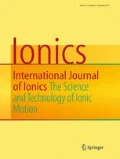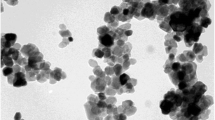Abstract
The plasticized composite solid polymer electrolytes (CSPE) involving polymer blends poly(methyl methacrylate)-poly(styrene-co-acrylonitrile) (PMMA-SAN), plasticizers ethylene carbonate (EC), and propylene carbonate (PC) with lithium triflate (LiCF3SO3) as salt and varying concentration of composite nano-filler zirconium oxide (ZrO2) is prepared by solution casting technique using THF as solvent. The powder X-ray diffraction (XRD) studies reveal amorphous nature of the CSPE samples. Fourier transform infrared (FT-IR) spectroscopy studies reveal interaction of Li+ ion with plasticizers, both C=O and OCH3 group of the PMMA, while nitrile group of SAN is inert. AC impedance and dielectric studies reveal that the ionic conductivity (σ), dielectric constant (ε’), and dielectric loss (ε”) of the prepared CSPE samples increase with increasing content of ZrO2 nano-filler up to 6 wt% and decrease with further additions. The temperature dependence of ionic conductivity follows Arrhenius relation and indicates ion-hopping mechanism. The sample Z2 (6 wt% ZrO2) with relaxation time τ of 8.13 × 10–7 s possess lowest activation energy (Ea = 0.23 eV) and highest conductivity (2.32 × 10–4 S cm−1) at room temperature. Thermogravimetric analysis (TGA) reveals thermal stability of highest conducting sample Z2 up to 321 °C after complete removal of residual solvent, moisture, and its impurities. Differential scanning calorimetric (DSC) studies reveal absence of glass transition temperature (Tg) corresponding to atactic PMMA for the CSPE Z2, while isotactic PMMA component shows Tg around 70 °C, which is due to increased interaction of filler with PMMA leading to change in its tacticity. Scanning electron microscopy (SEM) analysis reveals blending of PMMA/SAN polymers and lithium triflate salt. The incorporation of nano-filler ZrO2 leads to change in surface topology of polymer matrix. Rough surface of the CSPE Z2 leads to new pathway for ionic conduction leading to maximum ionic conductivity.












Similar content being viewed by others
References
Muldoon J, Bucur CB, Boaretto N, Gregory T, Noto VD (2015) Polymers: opening doors to future batteries. Polym Rev 55:208–246
Thiam A, Antonelli C, Iojoiu C, Alloin F, Sanchez JY (2017) Optimizing ionic conduction of poly(oxyethylene) electrolytes through controlling the cross-link density. Electrochim Acta 240:307–315
Noto VD, Lavina S, Giffin GA, Negro E, Scrosati B (2011) Polymer electrolytes: Present, past and future. Electrochim Acta 57:4–13
Quartarone E, Mustarelli P (2011) Electrolytes for solid-state lithium rechargeable batteries: recent advances and perspectives. Chem Soc Rev 40:2525–2540
Sekhon SS, Krishnan P, Singh B, Yamada K, Kim CS (2006) Proton conducting membrane containing room temperature ionic liquid. Electrochim Acta 52:1639–1644
Singh PK, Kim KW, Rhee HW (2009) Development and characterization of ionic liquid doped solid polymer electrolyte membranes for better efficiency. Synth Met 159:1538–1541
Ramesh S, Shanti R, Durairaj R (2011) Effect of ethylene carbonate in poly (methyl methacrylate)-lithium tetraborate based polymer electrolytes. J Non-Cryst Solids 357:1357–1363
Weston JE, Steele BCH (1982) Effects of inert fillers on the mechanical and electrochemical properties of lithium salt-poly(ethylene oxide) polymer electrolytes. Solid State Ionics 7:75–79
Scrosati B, Croce F, Persi L (2000) Impedance spectroscopy study of PEO-based nanocomposite polymer electrolytes. Electrochem Soc 147:1718
Croce F, Appetecchi GB, Persi L, Scrosati B (1998) Nanocomposite polymer electrolytes for lithium batteries. Nature 394:456–458
Bertasi F, Vezzu K, Giffin GA, Nosach T, Sideris P, Greenbaumd S, Vittadello M, Noto VD (2014) Single-ion-conducting nanocomposite polymer electrolytes based on PEG400 and anionic nanoparticles: Part 2. Electrical characterization. Int J Hydrog Energy 39:2884–2895
Shahi K, Wagner JB (1980) Fast ion transport in silver halide solid solutions and multiphase systems. Appl Phys Lett 37:757–759
Do NST, Schaetzl DM, Dey B, Seabaugh AC, Shirey SKF (2012) Influence of Fe2O3 Nanofiller Shape on the Conductivity and Thermal Properties of Solid Polymer Electrolytes: Nanorods versus Nanospheres. J Phys Chem C 116:21216–21223
Xiong HM, Zhao X, Chen JS (2001) New polymer−inorganic nanocomposites: PEO−ZnO and PEO−ZnO−LiClO4 Films. J Phys Chem B 105:10169–10174
Ali AMM, Yahya MZA, Bahron H, Subban RHY, Harun MK, Atan I (2007) Impedance studies on plasticized PMMA-LiX [X: CF3SO3 −, N(CF3SO2)2 −] polymer electrolytes. Mater Lett 61:2026–2029
Rajendran S, Shanthi Bama V, Ramesh Prabhu M (2010) Effect of lithium salt concentration in PVAc/PMMA-based gel polymer electrolytes. Ionics 16(1):27–32
Ali U, Karim KJ, Buang NA (2015) A review of the properties and applications of poly (methyl methacrylate) (PMMA). Polym Rev 55(4):678–705
Kumaraswamy GN, Ranganathaiah C, Deepa Urs MV, Ravikumar HB (2006) Miscibility and phase separation in SAN/PMMA blends investigated by positron lifetime measurements. Eur Polym J 42:2655–2666
Miao D, Jianhua G, Qiang Z (2004) Dynamic rheological behavior and morphology near phase-separated region for a LCST-type of binary polymer blends. Polymer 45:6725–6730
Othman L, Chew KW, Osman Z (2007) Impedance spectroscopy studies of poly (methyl methacrylate)-lithium salts polymer electrolyte systems. Ionics 13:337–342
Agrawal RC, Pandey GP (2008) Solid polymer electrolytes: materials designing and all-solid-state battery applications: an overview. J Phys D Appl Phys 41:223001(18pp
Austin Suthanthiraraj S, Johnsi M (2017) Nanocomposite polymer electrolytes. Ionics 23:2531–2542
Ramesh S, Yi LJ (2009) Structural, thermal, and conductivity studies of high molecular weight poly(vinylchloride)-lithium triflate polymer electrolyte plasticized by dibutyl phthalate. Ionics 15:725–730
Sharma P, Kanchan DK, Gondaliya N (2013) Effect of ethylene carbonate concentration on structural and electrical properties of PEO–PMMA polymer blends. Ionics 19:777–785
Rajendran S, Mahendran O, Mahalingam T (2002) Thermal and ionic conductivity studies of plasticized PMMA/PVdF blend polymer electrolytes. Eur Polym J 38:49–55
Su’ait MS, Ahmad A, Hamzah J, Rahman MYA (2011) Effect of lithium salt concentrations on blended 49% poly(methyl methacrylate) grafted natural rubber and poly(methyl methacrylate) based solid polymer electrolyte. Electrochim Acta 57:123–131
Azli AA, Manan NSA, Kadir MFZ (2015) Conductivity and dielectric studies of lithium trifluoromethanesulfonate doped polyethylene oxide-graphene oxide blend based electrolytes. Adv Mater Sci Eng:Art Id 145735:1–10
Mural PKS, Banerjee A, Rana MS, Shukla A, Padmanabhan B, Bhadra S, Madras G, Bose S (2014) Polyolefin based antibacterial membranes derived from PE/PEO blends compatibilized with amine terminated graphene oxide and maleated PE. J Mater Chem A 2(41):17635–17648
Chen HW, Lin TP, Chang FC (2002) Ionic conductivity enhancement of the plasticized PMMA/LiClO4 polymer nanocomposite electrolyte containing clay. Polymer 43(19):5281–5288
Kumar R, Sharma JP, Sekhon SS (2005) FTIR study of ion dissociation in PMMA based gel electrolytes containing ammonium triflate: Role of dielectric constant of solvent. Eur Polym J 41:2718–2725
Chew KW, Tan KW (2011) The Effects of Ceramic Fillers on PMMA-Based Polymer Electrolyte Salted With Lithium Triflate, LiCF3SO3. Int J Electrochem Sci 6:5792–5801
Helan Flora X, Ulaganathan M, Shanker Babu R, Rajendran S (2012) Evaluation of lithium ion conduction in PAN/PMMA-based polymer blend electrolytes for Li-ion battery applications. Ionics 18:731–736
Ramesh S, Ang GP (2010) Impedance and FTIR studies on plasticized PMMA–LiN(CF3SO2)2 nanocomposite polymer electrolytes. Ionics 16(5):465–473
Deka M, Kumar A (2010) Enhanced ionic conductivity in novel nanocomposite gel polymer electrolyte based on intercalation of PMMA into layered LiV3O8. J Solid State Electrochem 14:1649–1656
TianKhoon L, Ataollahi N, Hassan NH, Ahmad A (2016) Studies of porous solid polymeric electrolytes based on PVdF and PMMA grafted natural rubber for applications in electrochemical devices. J Solid State Electrochem 20:203–213
Ramesh S, Wen LC (2010) Investigation on the effects of addition of SiO2 nanoparticles on ionic conductivity, FTIR, and thermal properties of nanocomposite PMMA–LiCF3SO3–SiO2. Ionics 16(3):255–262
Rajendran S, Uma T (2000) Effect of ZrO2 on conductivity of PVC-PMMA-LiBF4-DBP polymer electrolytes. Bull Mater Sci 23(1):31–34
Gross S, Camozzo D, Noto VD, Armelao L, Tondello E (2007) PMMA: a key macromolecular component for dielectric low-κ hybrid inorganic–organic polymer films. Eur Polym J 43(3):673–696
Polu AR, Rhee H-W, Kim DK (2015) New solid polymer electrolytes(PEO20–LiTDI–SN) for lithium batteries: structural, thermal and ionic conductivity studies. J Mater Sci Mater Electron 26(11):8548–8554
Jacob MME, Prabaharan SRS, Radhakrishna S (1997) Effect of PEO addition on the electrolytic and thermal properties of PVDF-LiClO4 polymer electrolytes. Solid State Ionics 104(3-4):267–276.
Rahman MYA, Ahmad A, Lee TK, Farina Y, Dahlan HM (2012) LiClO4 salt concentration effect on the properties of PVC-modified low molecular weight LENR50-based solid polymer electrolyte. J Appl Polym Sci 124(3):2227–2233
Lee TK, Afiqah S, Ahmad A, Dahlan HM, Rahman MYA (2012) Temperature dependence of the conductivity of plasticized poly(vinyl chloride)-low molecular weight liquid 50% epoxidized natural rubber solid polymer electrolyte. J Solid State Electrochem 16:2251–2260
Rajendran S, Mahendran O, Krishnaveni K (2003) Effect of CeO2 on Conductivity of PMMA/PEO polymer blend electrolytes. J New Mater Electrochem Syst 6:25–28
Samsudin AS, Isa MIN (2012) Structural and ionic transport study on CMC doped NH4Br: a new type of biopolymer electrolytes J Appl Sci 12(2):174–179
Rajendran S, Sivakumar M, Subadevi R (2004) Investigations on the effect of various plasticizers in PVA–PMMA solid polymer blend electrolytes. Mater Lett 58:641–649
Jeon JD, Kwak SY, Cho BW (2005) Solvent-free polymer electrolytes: I. preparation and characterization of polymer electrolytes having pores filled with viscous P(EO‐EC)/LiCF3SO3. J Electrochem Soc 152(8):A1583–A1589
Aravindan V, Vickraman P (2007) A novel gel electrolyte with lithium difluoro(oxalato)borate salt and Sb2O3 nanoparticles for lithium ion batteries. Solid State Sci 9:1069–1073
Shastry S, Rao KJ (1991) ac conductivity and dielectric relaxation studies in AgI-based fast ion conducting glasses. Solid State Ionics 44:187–198
Buraidah MH, Teo LP, Majid SR, Arof AK (2009) Ionic conductivity by correlated barrier hopping in NH4I doped chitosan solid electrolyte. Phys B Condens Matter 404:1373–1379
Woo HJ, Majid SR, Arof AK (2012) Dielectric properties and morphology of polymer electrolyte based on poly(ɛ-caprolactone) and ammonium thiocyanate. Mater Chem Phys 134:755–761
Mishra R, Rao KJ (1998) Electrical conductivity studies of poly(ethyleneoxide)-poly(vinylalcohol) blends. Solid State Ionics 106:113–127
Ramesh S, Yuen TF, Shen CJ (2008) Conductivity and FTIR studies on PEO–LiX [X: CF3SO3 −, SO4 2−] polymer electrolytes. Spectrochim Acta A Mol Biomol Spectrosc 69:670–675
Fuchs K, Chr F, Weese J (1996) Viscoelastic properties of narrow-distribution poly(methyl methacrylates). Macromolecules 29:5893–5901
Rohr KS, Kulik AS, Beckham HW, Ohlemacher A, Pawelzik U, Boeffel C, Spiess HW (1994) Molecular nature of the .beta. relaxation in poly(methyl methacrylate) investigated by multidimensional NMR. Macromolecules 27:4733–4745
Marcinek M, Bac A, Lipka P, Zaleska A, Zukowska G, Borkowska R, Wieczorek W (2000) Effect of Filler Surface Group on Ionic Interactions in PEG−LiClO4−Al2O3Composite Polyether Electrolytes. J Phys Chem Sect B 104:11088–11093
Ramly K, Isa MIN, Khiar ASA (2011) Conductivity and dielectric behaviour studies of starch/PEO+x wt-%NH4NO3polymer electrolyte. Mater Res Innov 15:S82–S85
Ramesh S, Wong KC (2009) Conductivity, dielectric behaviour and thermal stability studies of lithium ion dissociation in poly(methyl methacrylate)-based gel polymer electrolytes. Ionics 15:249–254
Brandrup J, Immergut EH, Grulke EA, Abe A, Bloch DR (1999) Polymer handbook, 4th edn. Wiley, New York
Song JM, Kang HR, Kim SW, Lee WM, Kim HT (2003) Electrochemical characteristics of phase-separated polymer electrolyte based on poly(vinylidene fluoride–co-hexafluoropropane) and ethylene carbonate. Electrochim Acta 48:1339–1346
Prasanth R, Aravindan V, Srinivasan M (2012) Novel polymer electrolyte based on cob-web electrospun multi component polymer blend of polyacrylonitrile/poly(methyl methacrylate)/polystyrene for lithium ion batteries—preparation and electrochemical characterization. J Power Sources 202:299–307
Dai Pre M, Martucci A, Martin DJ, Lavina S, Noto VD (2015) Structural features, properties, and relaxations of PMMA-ZnO nanocomposite. J Mater Sci 50:2218–2228
Jayathilaka PARD, Dissanayake MAKL, Albbinsson I, Mellander BE (2002) Effect of nano-porous Al2O3 on thermal, dielectric and transport properties of the (PEO)9LiTFSI polymer electrolyte system. Electrochim Acta 47:3257–3268
Ataollahi N, Ahmad A, Hamzah H, Rahman MYA, Mohamed NS (2012) Preparation and Characterization of PVDF-HFP/MG49 Based Polymer Blend Electrolyte. Int J Electrochem Sci 7:6693–6703
Funding
One of the authors (S.V. Ganesan) thanks the UGC, Govt. of India, for providing him FDP Fellowship vide sanction letter FIP-TNMK 015/002(TF) under XII Plan.
Author information
Authors and Affiliations
Corresponding author
Electronic supplementary material
ESM 1
(DOC 49 kb)
Rights and permissions
About this article
Cite this article
Ganesan, S.V., Mothilal, K.K. & Ganesan, T.K. The role of zirconium oxide as nano-filler on the conductivity, morphology, and thermal stability of poly(methyl methacrylate)–poly(styrene-co-acrylonitrile)-based plasticized composite solid polymer electrolytes. Ionics 24, 3845–3860 (2018). https://doi.org/10.1007/s11581-018-2529-z
Received:
Revised:
Accepted:
Published:
Issue Date:
DOI: https://doi.org/10.1007/s11581-018-2529-z




